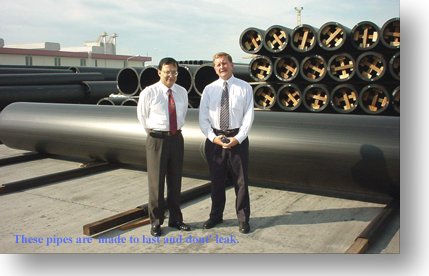Reflections back on what went wrong.
While the SET is boring we continue to review the latest literature on what went wrong in SE Asia in 1997. Last Friday (May 12), we visited in person KWH (33.5) a company whose stock price went up some 40% since our first recommendation on January 27 2000 called: "KWH(28.25), is no pipe dream". We still like this company and will soon have a complete updated report from our half day long visit to management and factory. We still rate KWH a "strong buy"!,P. This firm should continue to pay a near tax excempt dividend of close to 5.00 Baht per share and is set to earn more then 10 Baht per share in year 2001. The current p/e is a ridiculous low 4.1 , the book value is around 33Baht per share and the current yield on a just paid 4.80 Baht dividend payment is 14% on current prices.
We still like this company and will soon have a complete updated report from our half day long visit to management and factory. We still rate KWH a "strong buy"!,P. This firm should continue to pay a near tax excempt dividend of close to 5.00 Baht per share and is set to earn more then 10 Baht per share in year 2001. The current p/e is a ridiculous low 4.1 , the book value is around 33Baht per share and the current yield on a just paid 4.80 Baht dividend payment is 14% on current prices.
KWH is a leader in it’s growing industry and the regions lowest cost producer -when it comes to larger size pipe diameters. A second factory is being planned for next year so to increase capacity. KWH has not had a capital increase since getting listed on the SET. The company went public in late 1995 for 51 Baht per share. Then earnings per share, were almost half of what they are currently.
All in all this is EXACTLY the sort of stock I like here and want to be on record stating so.***
Indications of the impending economic crisis were evident in Bangkok by the early 1990s. Neither Asian entrepreneurs nor western investors should have been caught unawares. In early 1995 many Bangkok offices stood vacant and yet real estate developers continued to borrow and build. After a trip to Bangkok in December 1994, Ramo and Porter from FX Concepts Inc. wrote a letter to then Governor of the Bank of Thailand predicting the looming crisis.
At this time Bangkok office vacancy was around 20 % and yet another 32,087,730 square meters likely to enter the market before the end of 1997. This would bring the supply to 7,142,325 square meters of which 79 % would have been completed since 1992. It was stated that no matter how fast Thailand’s growth would be the additional space would be filled with difficulty. They suggested that these statistics indicated that Bangkok might be on the verge of a real estate crisis. Despite these warnings no preventative actions were taken.
Thailand: From economic Miracle to Economic Crisis
Thailand’s economic growth began in the late 1950s with the rise to power of Field Marshal Sarit Thanart. He changed institutional agreements in a way that helped him politically as well as creating conditions for economic growth. In an effort to undermine his opponents whose main bases were in state industries Sarit focused on the private sector. Macroeconomic agency control was handed to the technocrats who enjoyed incredible leeway in policy making. Some officials used this power to promote macroeconomic stability and gain control over the budgetary process. Many line ministries such as industry commerce and agriculture remained heavily politicized and were used for patronage purposes. An implicit agreement existed that technocrats would not encroach on the sectoral and microeconomic mismanagement that benefited the political masters while the latter would allow the technocrats to keep control over the macroeconomy.
These agreements led to rapid economic growth because of the favorable environment for profitable private investment and macroeconomic stability. Thailand achieved incredible low rates of inflation, realistic exchange rates, cautious fiscal policies and hard budget constraints for private enterprises. Furthermore it was ensured that vulnerable Chinese entrepreneurs property would not be confiscated. This was done either by entrepreneurs finding patrons in the military or civilian bureaucracy, or by joining joint ventures with foreign firms.
The agreements also created incentives for firms to plan well and operate efficiently. This was mainly through refusing to use state funds to bail out firms in difficulties. Also competitive clientelism encouraged competition among firms and discouraged monopolies. Intra elite rivalries insured that potential entrepreneurs could always find patrons so there was a constant flow of new private sector entrants. This type of clientelism tended to expand not limit the range of opportunities for entrepreneurs.
The Sarit regime also established a Board of Investment (BoI) possessing the power to grant a range of investment incentives. The BoI could grant firms various tax and tariff exemptions encouraging investment. This led to the rapid rise of import substituting industries in the 1960s. In the early 1970s the BoI began offering a range of export incentives. Exports grew rapidly due to a combination of shifting comparative advantage, astute economic policies and institutional arrangements. However although Thailand possessed strong exports in labor intensive industries such as textiles it had a weakness in higher value added exports. This was due to: institutional and political features of key governmental agencies; a trade regime that superimposed export promotion on protection and ineffective efforts at technology development.
Between 1988 and 1995 Thailand’s exports growth rate was 28 percent per annum. By 1996 this had dropped to zero due to a slowing of world trade, lower demand for electronic products, baht depreciation and high domestic inflation and interest rates. But more importantly were wage increases. Between 1982 and 1994 Thai real wages had increased by 70 %. The biggest drops in export growth occurred in the lower wage labor intensive exports that had been the major source of export growth from the mid 1980s to early 1990s. Overall exports of labor intensive manufactured goods declined approximately 14.6 % through the first 11 months in 1996. Furthermore Thai exports faced increased competition from other developing countries.
The origins of the economic crises were rooted in changes in global capital markets expected to benefit Thailand. The large amount of investment funds made available as a result of these changes could have been used to upgrade firm’s export capacities, improve infrastructure and training and education of the work force. But instead the inflows led to economic disaster.
The way the Bank of Thailand proceeded with financial liberalization was the first reason for economic disaster. It made it easier for foreign funds to flow into Thailand, maintaining high domestic interest rates and keeping the baht pegged to the dollar. In 1993 42 BIBF licenses were granted to Thai and foreign commercial banks allowing them to engage in a number of foreign exchange activities. Monitoring the increased number of finance firms and foreign inflows was difficult.
Maintaining high interest rates in order to limit aggregate demand and keep inflation low was the second policy mistake. High domestic interest rates ensured that firms could borrow foreign loans at lower cost than they could borrow locally. The bank of Thailand’s effort in 1995 to slow down an overheated economy by increasing interest rates just caused foreign borrowing to grow more rapidly. Furthermore most were short-term loans and not hedged against currency fluctuations.
The third mistake was to keep the baht pegged to a range of currencies where the dollar was weighted at 80 % of the total. With the rise in the dollar in the mid 1990s Thai exports became less competitive contributing to export difficulties. Furthermore borrowers were led to believe that the government would bail them out under currency devaluation.
Because much of the capital flowing into Thailand had not been used productively the previous three moves had disastrous effects. Much of the capital inflow went into real estate and low yielding commercial and industrial products. Capital flowed into real estate because it could be used as collateral for bank loans. Most business in Thailand continued to be family orientated and relied heavily on bank borrowing to expand. Financial institutions provide loans more readily when land is put up as collateral. As land prices were rising rapidly the investment paid off additionally in terms of the ability to float more debt. Again part of this was invested in real estate exacerbating the problem. Also the prolonged economic boom and large inflows of foreign funds had contributed to inflation making it more attractive to produce for domestic consumption thus more money went into protected sectors such as property, petrochemicals and steel.
Risky lending by commercial banks created asset price inflation. This was exacerbated by the globalization of financial markets allowing the asset bubble to grow larger than it would otherwise have done. When three of the commercial banks ran into trouble between 1983 and 1986 the government bailed them out with over 12 billion Baht. The World Bank warned Thailand that stricter bankruptcy and restructuring provisions were needed. This advice was not followed. When the Bangkok Bank of commerce ran into trouble in 1994 and 1995 the bank of Thailand supported it with nearly $7 billion even though BBC had violated several central bank orders and engaged in fraudulent behavior. By 1997 providing bailouts became increasingly difficult for the bank of Thailand who also had to defend the baht from attacks from foreign speculators. By July the Bank of Thailand had essentially exhausted a foreign exchange reserve defending the baht and was forced to announce a managed float on July 2nd.
The average debt/equity ratio among the listed non-financial companies rose from 1.58 to 1.98 between 1994 and 1996. As borrowers converted baht into dollars they pushed the baht further down by their actions. A downward spiral of asset deflation and disintermediation began. (As thaistocks.com notes from
other sources, net profit margins dropped just as financial leverage increased for much of corporate Thailand, during the boom "go-go" years of 1992 to 1996.
When macroeconomic agencies had firm control over monetary and fiscal policy and the baht was pegged to the dollar Government instability had relatively little influence on economy performance. Now that the baht is no longer pegged to the dollar there exists a direct connection between Thailand’s domestic politics and international confidence in its currency. Thailand’s political system has undermined investor confidence and the capacity to address economic problems for a number of reasons. First is the lack of input from political parties in policy issues. Since 1932 central national policy issues have remained in the hands of the military or technocrats. Thai political parties have been described merely as "vehicles for seizing control over ministerial resources".
A second key weakness is that the electoral system encourages patronage-based rather than policy-based parties. The multimember system of voting results in high cost campaigning and encourages cabinet instability. Most parties today are understood to be "loose factions of politicians who readily leave the party and join another party which has a better chance of getting into the cabinet." Thailand went through four finance ministers in six months during the crisis; precisely the time when expertise and stability was needed the most.
The financial crises increased the effectiveness of those seeking change in the financial system. It also weakened the blocking power of the banking families and business groups who had benefited from past institutional arrangements. Between November 1997 and August 1998 the government closed fifty six finance companies and took over four failing commercial banks. They also tightened standards for non-performing loans and initiated reforms in the Bank of Thailand. Tighter bankruptcy and restructuring policies have been implemented and capital adequacy regulations put in place.
An investigation into the Bank of Thailand recommended substantial changes to strengthen the management of the bank, reduce factionalism and increase it’s autonomy from political interference. In the long run these changes will result in Thailand having a stronger and more transparent financial system. Assets of financial companies are being sold off but this is proceeding very slowly. Non performing loans were estimated to peak at 35 % of outstanding loans and local banks were estimated to need $20 billion to deal with these non performing loans.
Unless Thailand’s industrial competitiveness is upgraded Thailand in the long run will be unable to sustain economic growth. Export competitiveness may seem to be less of a pressing issue due to the effect of the weaker baht. Exports grew by approximately 10 % in 1997 with the falling value of the baht helping to increase exports of automobiles, autoparts, electrical and electronic products. But it is necessary to upgrade the quality of exports such as clothing and move into newer higher value added exports. In the next 10 - 15 years Thailand should be able to keep its comparative advantage in medium to high technology product assembly and exports. Increasing value added requires human resource development. In 1997 nearly 80 % of Thai workers had only a primary education or less and the lowest ratio of science and technology graduates of any country in Asia.
Finally in addition to upgrading industrial competitiveness and making changes in the financial sector Thailand needs to undergo political reforms. A stable government is needed which can address the problems of financial reform and industrial upgrading.
The above is the summary of the chapter on Thailand. (page 170 to 207) of the book: Asian Contagion, The Causes and Consequences of a Financial Crisis. (1999)

Introduction

